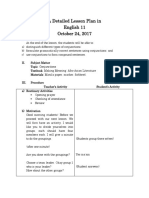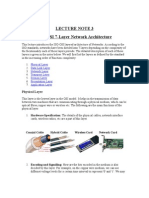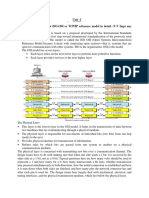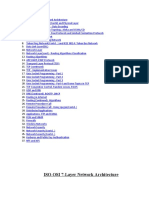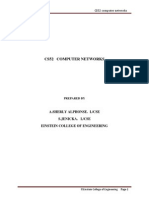Q1. Explain All Design Issues For Several Layers in Computer. What Is Connection Oriented and Connectionless Service?
Q1. Explain All Design Issues For Several Layers in Computer. What Is Connection Oriented and Connectionless Service?
Uploaded by
Shabbir KahodawalaCopyright:
Available Formats
Q1. Explain All Design Issues For Several Layers in Computer. What Is Connection Oriented and Connectionless Service?
Q1. Explain All Design Issues For Several Layers in Computer. What Is Connection Oriented and Connectionless Service?
Uploaded by
Shabbir KahodawalaOriginal Description:
Original Title
Copyright
Available Formats
Share this document
Did you find this document useful?
Is this content inappropriate?
Copyright:
Available Formats
Q1. Explain All Design Issues For Several Layers in Computer. What Is Connection Oriented and Connectionless Service?
Q1. Explain All Design Issues For Several Layers in Computer. What Is Connection Oriented and Connectionless Service?
Uploaded by
Shabbir KahodawalaCopyright:
Available Formats
Q1. Explain all design issues for several layers in Computer. What is connection oriented and connectionless service?
Various key design issues are present in several layers in computer networks. The important design issues are: 1. Addressing: Mechanism for identifying senders and receivers, on the network need some form of addressing. There are multiple processes running on one machine. Some means is needed for a process on one machine to specify with whom it wants to communicate. 2. Error Control: There may be erroneous transmission due to problem in communication circuits, physical medium, due to thermal noise and interference. Many error detecting and error correcting codes are known, but both ends of the connection must agree on which one being used. In addition, the receiver must have some mechanism of telling the sender which messages have been received correctly and which has not. 3. Flow control: If there is a fast sender at one end sending data to a slow receiver, then there must be flow control mechanism to control the loss of data by slow receivers. Some process will not be in position to accept arbitrarily long messages. Then, there must be some mechanism to disassembling, transmitting and then reassembling messages. 4. Multiplexing / Demultiplexing: If the data has to be transmitted on transmission media separately, it is inconvenient or expensive to setup separate connection for each pair of communicating processes. So, multiplexing is needed in the physical layer at sender end and demultiplexing is need at the receiver end. 5. Routing: When data has to be transmitted from source to destination, there may be multiple paths between them. An optimized (shortest) route must be chosen. This decision is made on the basis of several routing algorithms, which chooses optimized route to the destination. Connection oriented service: * The service user first establishes a connection, uses the connection and then releases the connection. * Once the connection is established between source and destination, the path is fixed. * The data transmission takes place through this path established. * The order of the messages sent will be same at the receiver end.
* Services are reliable and there is no loss of data. * Most of the time, reliable service provides acknowledgement is an overhead and adds delay. Connectionless Services: * In this type of services, no connection is established between source and destination. * Here there is no fixed path. Therefore, the messages must carry full destination address and each one of these messages are sent independent of each other. * Messages sent will not be delivered at the destination in the same order. Thus, grouping and ordering is required at the receiver end. * The services are not reliable. * There is no acknowledgement confirmation from the receiver. * Unreliable connectionless service is often called datagram service, which does not return an acknowledgement to the sender.
Q2. Discuss OSI Reference model.
The OSI model is based on a proposal developed by the International Standards Organization as a first step towards international standardization of the protocols used in the various layers. Its main objectives were to: * Allow manufacturers of different systems to interconnect equipment through a standard interfaces. * Allow software and hardware to integrate well and be portable on different systems. The principles that were applied to arrive at the seven layers are as follows:
The Physical Layer * The Physical layer coordinates the function required to carry a bit (0s and 1s) stream over a physical medium. * It defines electrical and mechanical specifications of cables, connectors and signaling options that physically link two nodes on a network. The Data Link Layer * The main task of the data link layer is to provide error free transmission. * The data link layer provides the functional and procedural means to transfer data between network entities and to detect and possibly correct errors that may occur in the physical layer. The Network Layer * The network layer ensures that each packet travels from its sources and destination successfully and efficiently. * The Network Layer deals with packets of data. The Transport Layer * The basic function of the transport layer is to accept data from the session layer, split it up into smaller units if need be, pass these to the network layer, and ensure that the pieces all arrive correctly at other end. * Furthermore, all this must be done efficiently, and in a way that isolates the upper layers from the inevitable changes in the hardware technology. Transport layer provides location and media independent end-to-end data transfer service to session and upper layers. The Session Layer * The session layer allows users on different machines to establish sessions between them. * A session allows ordinary data transport, as does the transport layer, but it also provides enhanced services useful in some applications. * A session might be used to allow a user to log into a remote timesharing systems or to
transfer a file between two machines. The Presentation Layer * The presentation layer is concerned with the syntax and semantics of the information transmitted. * In order to make it possible for computers with different representations to communicate, the data structure to be exchanged can be defined in an abstract way, along with a standard encoding to be used on the wire. The Application Layer * The application layer is the OSI layer closest to the end user. It means that both the OSI application layer and the user interact directly with the software application. * Application layer supports functions that control and supervise OSI application processes such as start/maintain/stop application, allocate/deallocate OSI resources, accounting, and check point and recovering.
Q3. Describe different types of Data transmission modes.
The different types of Data Transmission modes are: 1. Serial and Parallel Transmission Serial Transmission: In serial transmission one bit follows another, so we need only one communication channel rather than n to transmit data between two communicating devices. The advantage of serial over parallel transmission is that with only one communication channel, serial transmission reduces cost of transmission over parallel by roughly a factor of n. Parallel Transmission Binary data, consisting of 1 s and 0 s, may be organized into groups of n bits each. Computers produce and consume data in groups of bits much as we conceive of and use spoken language in the form of words rather than letters. By grouping, we can send data n bits at a time instead of 1. This is called parallel transmission. The mechanism for parallel transmission is a simple one: Use n wires to send n bits at one time. 2. Simplex, Half duplex and Full duplex Simplex In simplex communication mode, there is a one-way communication transmission. Television transmission is a good example of simplex communications. Half-duplex: In half-duplex mode, both units communicate over the same medium, but only one unit can send at a time. While one is in send mode, the other unit is in receiving mode.
Full duplex In Full-duplex transmission, data is transferred in both directions. Use of a full-duplex line improves efficiency as the line turn-around time required in a half-duplex arrangement is eliminated. It requires four wires. 3. Synchronous and Asynchronous transmission Synchronous Transmission In synchronous transmission, data transmission is tied to a clock. The bit stream is combined into longer frames, which may contain multiple bytes. Each byte, however, is introduced onto the transmission link without a gap between it and the next one. It is left to the receiver to separate the bit stream into bytes for decoding purpose. Timing becomes very important, therefore, because the accuracy of the received information is completely dependent on the ability of the receiving device to keep an accurate count of the bits as they come in. Asynchronous Transmission Asynchronous transmission is so named because the timing of a signal is unimportant. Instead, information is received and translated by agreed upon patterns. Patterns are based on grouping the bit stream into bytes. Extra bits are used to mark the beginning and end of bytes. This bit, usually a 0, is called the start bit. To let the receiver know that the byte is finished, 1 or more additional bits are appended to the end of the byte. These bits, usually 1s, are called stop bits.
Q4. Define Switching. What is the difference between circuit switching and Packet Switching?
Switching is defined a technique that inspects data packets as they are received, and forward them to destination. A switching system is a collection of switching elements arranged and controlled in such a way as to setup a communication path between any two distant points. A switching center of a telephone network comprising a switching network and its control and support equipment is called a central office. In computer communication, the switching technique used is known as packet switching or message switch (store and forward switching). In telephone network the switching method used is called circuit switching. Differences between circuit switching and packet switching: Circuit Switching Circuit switching is scheme in which the network sets up a circuit between nodes and terminals before the communication starts. Packet Switching Packet switching is a network communication method in which the data get transmitted in blocks, regardless of type and content, called packets.
Required dedicated transmission path The system decides on which route to follow, based on a resource-optimizing algorithm, and transmission goes according to the path. Messages are not stored The route is dedicated and exclusive Fixed bandwidth use No overhead bits after call setup Once connection is established, communication is fast and less error free
No dedicated path required Each packet has to find its own route to the destination, determined using the source and destination address Packets may be stored until delivered to destination There is no dedicated route. Each packet travels independent of each other. Dynamic use of bandwidth Overhead bits in each packet The packet needs to be re-transmitted every time when it gets lost, damaged before it is received in this method
Q5. Classify Guided medium (wired).Compare fiber optics and copper wire.
Guided Transmission Medium can be classified into Twisted Pair A twisted pair consists of two insulted copper wires, typically about 1 mm thick. The wires are twisted together in a helical form, just like a DNA molecule. Twisting is done because two parallel wires constitute a fine antenna. When the wires are twisted, the waves from different twists cancel out, so the wire radiates less effectively. Coaxial Cable The coaxial cable consists of a stiff copper wire as the core, surrounded by an insulating material. The insulator is encased by a cylindrical conductor, often as a closely-woven braided mesh. The outer conductor is covered in a protective plastic sheath. The construction and shielding of the coaxial cable give it a good combination of high bandwidth and excellent noise immunity. Optical Fiber A fiber-optic cable is made of glass or plastic and transmits signals in the form of light. Fiber optic cables are similar to coax. At the center is the glass core through which the light propagates.
The core is surrounded by a glass cladding with a lower index of refraction than the core, to keep all the light in the core. Comparison of Fiber Optics and Copper Wire Fiber Optics It can handle much higher band widths than copper. Fiber is not being affected by the power surges, electromagnetic interference, or power failures Fibers do not leak light and are quite difficult to tap. This gives them excellent security against potential wire tappers Fiber interfaces cost more Copper Wire Copper Wires handles lesser bandwidth than Fiber Optics Copper Wires could be attract electromagnetic interferences Lesser security against wire tapping Less Costlier
Q6. What are different types of satellites?
Four different types of satellite orbits can be identified depending on the shape and diameter of the orbit: GEO (Geostationary orbit) LEO (Low Earth Orbit) MEO (Medium Earth Orbit) or ICO (Intermediate Circular Orbit) HEO (Highly Elliptical Orbit) elliptical orbits The following figure clearly depicts their differencesOrbit Geostationary Altitude 36000 km above earth surface Coverage Suited for continuous, regional coverage using a single satellite. Can also be used equally effectively for global coverage using a minimum of three satellites Multi-satellite Visibility Mobile to satellite visibility decreases with increased latitude of the user. Poor Visibility in built-up, urban regions
GEO
LEO
Low Earth
500 -
The use of satellite diversity, by
orbit
1500 km
constellations of upwards of 3050 satellites are required for global, continuous coverage. Multi-satellite constellations of between 10 and 20 satellites are required for global coverage. Three or four satellites are needed to provide continuous coverage to a region
MEO Medium Earth 6000 orbit 20000 km
which more than one satellite is visible at any given time, can be used to optimize the link. This can be achieved by either selecting the optimum link or combining the reception of two or more links. Good to excellent global visibility, augmented by the use of satellite diversity techniques Particularly designed to provide high guaranteed elevation angle to satellite for Northern and Southern temperate latitudes
HEO
Highly elliptical orbit
Apogee: 40 000 50 000 km, Perigee: 1000km
You might also like
- A Detailed Lesson Plan in EnglishDocument14 pagesA Detailed Lesson Plan in EnglishroseNo ratings yet
- Strategy Inventory For Language Learning (SILL)Document6 pagesStrategy Inventory For Language Learning (SILL)ciedelle arandaNo ratings yet
- Data CommunicationDocument18 pagesData Communicationmukesh244No ratings yet
- Computer NetworkDocument32 pagesComputer NetworkTony StarkNo ratings yet
- Final Solved Asssignment Mb0035Document14 pagesFinal Solved Asssignment Mb0035Avinash SinghNo ratings yet
- Ec 407 Computer Communication: Pg. 1 Department of EceDocument25 pagesEc 407 Computer Communication: Pg. 1 Department of EceNandu V SNo ratings yet
- NetworkDocument67 pagesNetworkBiplov SapkotaNo ratings yet
- cs2 NotesDocument35 pagescs2 NotesMukul BhallaNo ratings yet
- Computer Network Soft Copy (Rashmita Forozaun)Document97 pagesComputer Network Soft Copy (Rashmita Forozaun)Asim Arunava Sahoo100% (1)
- Computer CommunicationsDocument190 pagesComputer Communicationsvanig05100% (1)
- Computer NetworksDocument190 pagesComputer NetworksSourav MukherjeeNo ratings yet
- Physical Layer: Coaxial Cable Hybrid Cable Wireless Card Network CardDocument8 pagesPhysical Layer: Coaxial Cable Hybrid Cable Wireless Card Network CardGovindNo ratings yet
- CN-Chap01 - Jul 2021Document40 pagesCN-Chap01 - Jul 2021TEJAS DALVINo ratings yet
- Computer NetworksDocument176 pagesComputer Networksnetra14520No ratings yet
- DC and CN Chapter-2Document53 pagesDC and CN Chapter-2habtamud655No ratings yet
- Unit 1Document29 pagesUnit 1DR.SHOBANA.R MBANo ratings yet
- Computer Networks (CS425) : ISO-OSI 7-Layer Network ArchitectureDocument8 pagesComputer Networks (CS425) : ISO-OSI 7-Layer Network Architecture919625484476No ratings yet
- Computernetwork For InterviewDocument9 pagesComputernetwork For InterviewSangeetha ShankaranNo ratings yet
- Computer NetworkDocument107 pagesComputer NetworkDr. Hitesh MohapatraNo ratings yet
- Networking NotesDocument10 pagesNetworking NotesADITYA RAJNo ratings yet
- UNIT 1 Computer Networks NotesDocument18 pagesUNIT 1 Computer Networks NotesdoctoraseenNo ratings yet
- Network Model ArchitectureDocument27 pagesNetwork Model ArchitectureS M AkashNo ratings yet
- Cloud NetworkingDocument26 pagesCloud NetworkingHeliosNo ratings yet
- Best Fit Topology Final1Document33 pagesBest Fit Topology Final1nahomsnewNo ratings yet
- CN Unit-1 Imp QA'sDocument29 pagesCN Unit-1 Imp QA'shajirasabuhiNo ratings yet
- Computer Networks BCADocument42 pagesComputer Networks BCAagnihotrisalil1234No ratings yet
- Definition of Switching TechniquesDocument5 pagesDefinition of Switching TechniquesJAVA ICSE And ISC Tutorials By Yogesh Bajpai sirNo ratings yet
- ISO-OSI 7-Layer Network ArchitectureDocument126 pagesISO-OSI 7-Layer Network Architecturerathore_meenakshi81No ratings yet
- Unit-Ii 2ND PartDocument7 pagesUnit-Ii 2ND PartRABIN SINGHANo ratings yet
- CN 1Document7 pagesCN 1T024KOUSTAV CHATTERJEENo ratings yet
- DCN SanjivaniDocument36 pagesDCN Sanjivanikhandareshobhit17No ratings yet
- DCCN Unit 1Document13 pagesDCCN Unit 1Dinesh PalavalasaNo ratings yet
- Unit 2 BBA VDocument32 pagesUnit 2 BBA Vaakanshatyagi030303No ratings yet
- Winter Semester 2023-24 - CSE3003 - ETH - AP2023246000860 - 2024-01-19 - Reference-Material-IDocument42 pagesWinter Semester 2023-24 - CSE3003 - ETH - AP2023246000860 - 2024-01-19 - Reference-Material-IVinit mehraNo ratings yet
- # TCP/IP Protocol Layers:-1.application Layer: Protocols UsedDocument8 pages# TCP/IP Protocol Layers:-1.application Layer: Protocols UsedPRIYANSHU KUMARNo ratings yet
- Data & InformationDocument10 pagesData & InformationMirsab RizviNo ratings yet
- All Unit ChatgptDocument75 pagesAll Unit ChatgptSAKSHAM PRASADNo ratings yet
- Data Communication and NetworkingDocument10 pagesData Communication and NetworkingAsadul HoqueNo ratings yet
- EMT 3202 - Notes 2Document30 pagesEMT 3202 - Notes 2burna.test22No ratings yet
- DC All Units-Dcet - Umar CoderDocument165 pagesDC All Units-Dcet - Umar Coderritif59968No ratings yet
- Week 8 (A)Document22 pagesWeek 8 (A)Abrar HussainNo ratings yet
- Chapter 5Document34 pagesChapter 5ingawalemadhura5722No ratings yet
- Osi ModelDocument94 pagesOsi Modelsumit_12100% (1)
- Web and Internet Technology - UNIT-1-3Document4 pagesWeb and Internet Technology - UNIT-1-3bfloveff69No ratings yet
- Networking For BeginneresDocument16 pagesNetworking For BeginneresRavi KumarNo ratings yet
- CN NotesDocument109 pagesCN Notesanujgargeya27No ratings yet
- Unit IiiDocument59 pagesUnit IiiMohd Abdul AleemNo ratings yet
- CC Notes Unit 1Document30 pagesCC Notes Unit 1Johns T MoncyNo ratings yet
- OSI Reference Model: Standardization, in The Year 1984Document9 pagesOSI Reference Model: Standardization, in The Year 1984anjali prasadNo ratings yet
- M7 NetworkingDocument9 pagesM7 NetworkingAnimesh SrivastavaNo ratings yet
- The TCPDocument4 pagesThe TCPSYAMANTA GARUDNo ratings yet
- Assignment-1: Internet & Multimedia TechnologyDocument6 pagesAssignment-1: Internet & Multimedia TechnologySwarnim ShuklaNo ratings yet
- CS52 Computer Networks-Slotted AlohaDocument122 pagesCS52 Computer Networks-Slotted AlohaAyman Ibrahim SabbahNo ratings yet
- 5 GTU Computer Network Mid Sem Exam PaperDocument14 pages5 GTU Computer Network Mid Sem Exam PaperNickHenryNo ratings yet
- Layers of OSI Model.Document6 pagesLayers of OSI Model.tahir ullahNo ratings yet
- Btcse CNDocument131 pagesBtcse CNWaseequeNo ratings yet
- Osi ModelDocument19 pagesOsi ModelPranav SaiNo ratings yet
- Components: - A Data Communication System Has 5 ComponentsDocument4 pagesComponents: - A Data Communication System Has 5 Componentspradhyumn_pnNo ratings yet
- 27 BCS53 2020121505394441Document27 pages27 BCS53 2020121505394441Pallavi BNo ratings yet
- Leonardi Notes Gabriele DiVittorio DiCaroDocument21 pagesLeonardi Notes Gabriele DiVittorio DiCaroKshitij SharmaNo ratings yet
- Computer Networks (CS425) : ISO-OSI 7-Layer Network ArchitectureDocument5 pagesComputer Networks (CS425) : ISO-OSI 7-Layer Network ArchitectureAnish VeettiyankalNo ratings yet
- Hacking Network Protocols: Unlocking the Secrets of Network Protocol AnalysisFrom EverandHacking Network Protocols: Unlocking the Secrets of Network Protocol AnalysisNo ratings yet
- Left Handers Lesson PlanDocument4 pagesLeft Handers Lesson PlanhannahNo ratings yet
- Ethnologue - Languages of The World - Browse by Language Family - Eberhard, Simons, Fennig 2019 SILDocument1 pageEthnologue - Languages of The World - Browse by Language Family - Eberhard, Simons, Fennig 2019 SILkrenari68No ratings yet
- Financial Management in SchoolDocument156 pagesFinancial Management in SchoolTeody Villegas Limot50% (2)
- Comparative Theory of 3 Instructional DesignsDocument12 pagesComparative Theory of 3 Instructional DesignsVonne HeartfordNo ratings yet
- Interview Assessment 2Document2 pagesInterview Assessment 2api-539178993No ratings yet
- Siop Lesson Plan With ReflectionDocument6 pagesSiop Lesson Plan With Reflectionapi-315708883100% (2)
- Materials 2nd Foreign Language Learning TeachingDocument13 pagesMaterials 2nd Foreign Language Learning TeachingPhuong0% (1)
- CeatDocument6 pagesCeatYashvendra RawatNo ratings yet
- Student Reader, Empowerment TechnologiesDocument57 pagesStudent Reader, Empowerment TechnologiesBev Garcia100% (1)
- Sertifikat 2Document2 pagesSertifikat 2teshaNo ratings yet
- English ElectiveDocument10 pagesEnglish Electivedadan vishwakarmaNo ratings yet
- Teen Patti Life DM StrategyDocument16 pagesTeen Patti Life DM StrategyBarin DasNo ratings yet
- My ReflectionDocument1 pageMy ReflectionSalem Quiachon IIINo ratings yet
- Handouts On How To Write A Philosophy of EducationDocument3 pagesHandouts On How To Write A Philosophy of EducationMarvaiiix100% (1)
- Marketing Mind MapDocument3 pagesMarketing Mind MapsiyonaNo ratings yet
- CONEAPP 1 - 2nd Quarter Post AssessmentDocument10 pagesCONEAPP 1 - 2nd Quarter Post AssessmentDaddy ChillNo ratings yet
- 07VWCM6007 Anokhee AminDocument17 pages07VWCM6007 Anokhee Aminanokhee aminNo ratings yet
- Listening Review 1 - TestDocument6 pagesListening Review 1 - TestNguyễn Thị Thanh ThưNo ratings yet
- Task 2 - Diego Torres CorderoDocument4 pagesTask 2 - Diego Torres CorderoDiego TorresNo ratings yet
- Sara Martin Education Resume 2021Document1 pageSara Martin Education Resume 2021api-547903124No ratings yet
- How To Build A Personal Brand Strategy and Communication PlanDocument5 pagesHow To Build A Personal Brand Strategy and Communication PlancccqNo ratings yet
- Multimedia System - Quiz 2Document22 pagesMultimedia System - Quiz 2Alesa DaffonNo ratings yet
- Why A Global LanguageDocument3 pagesWhy A Global LanguageGabriel Dan BărbulețNo ratings yet
- PunctuationDocument7 pagesPunctuationapi-296525503No ratings yet
- Personal Portfolio Reflection-2Document2 pagesPersonal Portfolio Reflection-2api-336975079No ratings yet
- Lesson Plan Kls 2Document6 pagesLesson Plan Kls 2wathy100% (1)
- Assignment 04Document5 pagesAssignment 04mpho molalaNo ratings yet
- Local Stud DraftDocument2 pagesLocal Stud DraftJeremiahNo ratings yet
